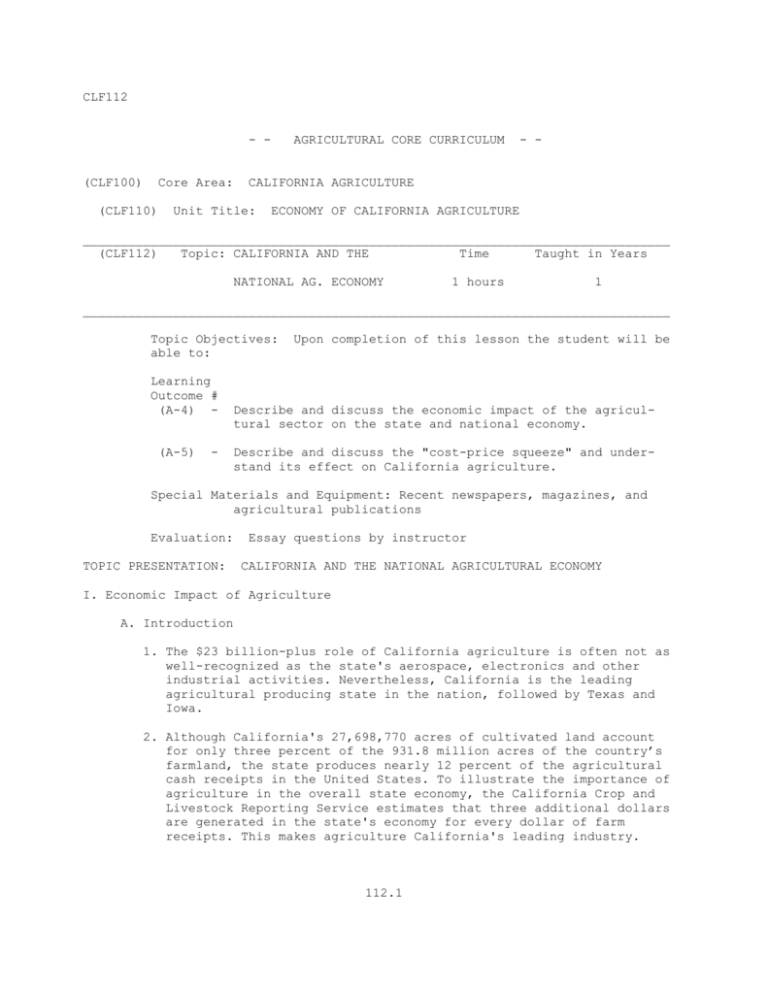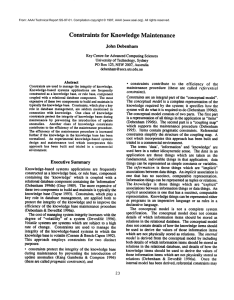CLF112
advertisement

CLF112 - (CLF100) Core Area: (CLF110) AGRICULTURAL CORE CURRICULUM - - CALIFORNIA AGRICULTURE Unit Title: ECONOMY OF CALIFORNIA AGRICULTURE ______________________________________________________________________________ (CLF112) Topic: CALIFORNIA AND THE Time Taught in Years NATIONAL AG. ECONOMY 1 hours 1 ______________________________________________________________________________ Topic Objectives: able to: Learning Outcome # (A-4) (A-5) - Upon completion of this lesson the student will be Describe and discuss the economic impact of the agricultural sector on the state and national economy. Describe and discuss the "cost-price squeeze" and understand its effect on California agriculture. Special Materials and Equipment: Recent newspapers, magazines, and agricultural publications Evaluation: TOPIC PRESENTATION: Essay questions by instructor CALIFORNIA AND THE NATIONAL AGRICULTURAL ECONOMY I. Economic Impact of Agriculture A. Introduction 1. The $23 billion-plus role of California agriculture is often not as well-recognized as the state's aerospace, electronics and other industrial activities. Nevertheless, California is the leading agricultural producing state in the nation, followed by Texas and Iowa. 2. Although California's 27,698,770 acres of cultivated land account for only three percent of the 931.8 million acres of the country’s farmland, the state produces nearly 12 percent of the agricultural cash receipts in the United States. To illustrate the importance of agriculture in the overall state economy, the California Crop and Livestock Reporting Service estimates that three additional dollars are generated in the state's economy for every dollar of farm receipts. This makes agriculture California's leading industry. 112.1 3. Of the ten leading agricultural counties in the United States, eight are located in California. Many of the state's counties rank high among the nation's agricultural producers. In fact, if Fresno County were a state, it would rank 29th in gross agricultural receipts among all states in the U.S. During the past 30 years, California has maintained its position as one of the nation's leading exporters of agricultural products, along with Illinois and Iowa. Leading export commodities include cotton lint, almonds, oranges, grapes, cereal grains such as rice and wheat, fruit and nuts, beef and alfalfa. At a time when foreign debt is at an all-time high, California's contributions as a commodity exporter are very important. B. Examples of Direct Impacts of Agriculture on the State Economy 1. Family farms (56,755 in the state) 2. Agricultural businesses/corporate farms (5,252 in the state) 3. Agricultural labor 4. Agricultural services, i.e., pest control, farm machinery sales and maintenance C. Examples of Indirect Impacts of Agriculture on the State Economy 1. Agricultural banking and finance 2. Transportation and storage industries 3. Advertising and marketing industries 4. Food processing industries 5. Federal, state and local agencies regulating and serving agriculture. D. Examples of California Agriculture's Impact at the National Level 1. California is a major source of foreign currency contributions to the national balance of payments (agriculture accounts for between 15 and 25 percent of our national income from trading partners) 2. California produces 25 percent of the nation's food (note California produces more than half of US produce) 3. California leads the nation in the production of over 45 crops 4. California leads the nation in the use of irrigated agriculture (8,712,893 acres from a national total of 55,058,128 acres for about 16% of the total acres) 112.2 _________________________________________________ ACTIVITY: Select an agriculture-related job and review its contribution to the economy of your area. _________________________________________________ II. The "Cost-Price Squeeze" A. The "cost-price squeeze" is an economic condition which keeps the payments (or "prices") farmers receive only slightly higher than their costs of producing a commodity. 1. Because farmers are so numerous and so spread out geographically, there is a high degree of competition. 2. Because many farmers produce the same commodities, the individual farmer cannot affect market prices by cutting production. Also, farmers are often reluctant to organize and act as a group. This is due to factors such as geographic distribution, different operating conditions, and the desire to operate independently. 3. Because of the perishable nature of the farmer's produce, and the seasonality of the industry, it is difficult for farmers to command high prices in the short term. All of these factors make farmers "price takers" (rather than "price fixers"). While this competitive environment works out well for the consumer, the farmer is caught in the "cost-price squeeze," where costs are always very close to the prices received. B. For those farming in California, the "cost-price squeeze" has some practical consequences: 1. Farmers are always looking for ways to lower costs such as supplies, equipment, labor and energy, in order to stay ahead of the "squeeze." 2. Farmers depend heavily on new technology to improve efficiency and reduce costs. It is no accident that farming in California is efficient and modern; it is an economic necessity. 3. Many farmers in California try to find "undeveloped markets," producing commodities for which supply and demand are not wellestablished. The new markets for ethnic foods, "baby vegetables" and fresh herbs are examples of these efforts. 4. Many California producers have organized to try and coordinate their marketing efforts. Examples are raisin, almond and citrus producers who have organized into cooperatives helping farmers solve some of their marketing difficulties. 112.3 _______________________________________________ ACTIVITY: Select a news item on an agricultural economic issue and: 1. analyze and summarize it in written form; 2. orally critique articles in class (debate); 3. encourage students to develop their findings into speeches. References: magazines, newspapers (e.g., Wall Street Journal), ag briefs, on-line bulletins. _________________________________________________ 112.4







